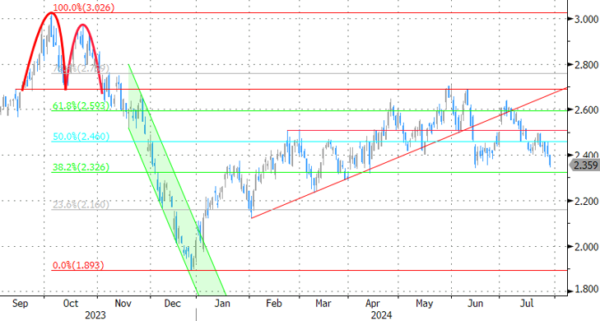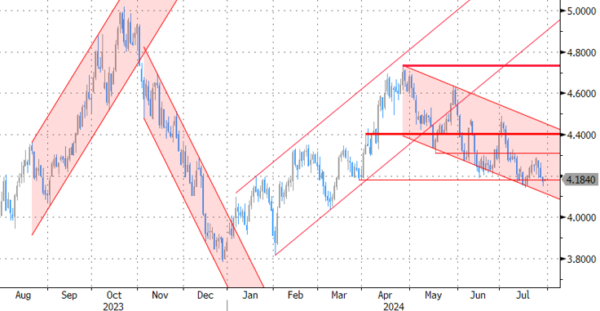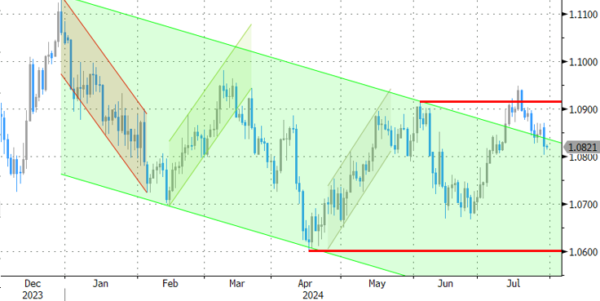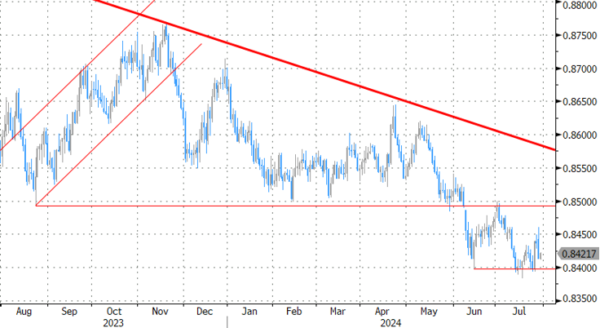Markets
German Bunds outperformed US Treasuries at the calm start of what is going to be busy week. Yields in the country dipped between 2.9 (2-yr) and 5.3 bps (30-yr), continuing the recent yield correction. US yields added up to 1.6 bps at the front after trading lower for most of the day. Longer maturities finished up to 2.8 bps lower but were also well off intraday lows with the turnaround happening when US dealings were in full swing. Treasury announcing lower borrowing estimates for the running quarter than expected in April gave US Treasuries some last-minute support (see below). Stock markets struggled in Europe (-0.97% EuroStoxx50, wiping out all Friday gains) and, after opening higher (mostly tech) finished virtually unchanged in the US. Bund outperformance and stock underperformance gave the dollar an upper hand against most global peers, the euro in particular. EUR/USD dropped from 1.086 at the open to 1.082 into the close. The trade-weighted dollar index printed some decent gains though they were bigger earlier on the day. DXY rose from 104.31 to 104.56. JPY stabilized near recent highs at USD/JPY 154.02. Sterling’s large intraday swings ended up in the currency erasing much of end of last week’s losses against the euro. EUR/GBP fell from as high as 0.846 to 0.841. UK chancellor Reeves yesterday announced the results of the audit into UK public finances. She said the Labour government had inherited £21.9 bn of “unfunded and undisclosed” spending commitments. She then outlined a series of measures to address this, amounting to some £5.5bn in savings. That leaves a shortfall of more than £16bn that will need to be taken into account when Labour will release its first budget, scheduled for October 30.
Skipping a fairly uneventful Asian session, we dive right into the economic calendar of today. It is jampacked with JOLTS job vacancies and the Conference Board consumer confidence in the US. A series of GDP releases is due in the euro area with the European wide figure published today as well. France is typically one of the first major nations to report growth and already did so this morning. Q2 GDP expanded by 0.3%, topping the 0.2% estimate and coming on an upwardly revised 0.3% in Q1. France’s economy is now 1.1% larger than the same period last year. With Germany’s reading still due it’s too soon to call for upward risks to the European figure (expected at 0.2% q/q). But even if these would materialize, unless they are material, we don’t expect it to leave a major mark on the euro nor yields. There are also important inflation numbers due as well. The German and Spanish outcome may set the tone for the European number tomorrow. While we think that (front-end) European yields shouldn’t ease much more given what is priced in for the ECB (slightly below-neutral terminal rate), risks remain tilted towards a further easing in a daily perspective, especially if the technical support zones start cracking (eg. 2.6% in Germany’s 2-yr, 2.91% in swap). That makes EUR/USD’s downside vulnerable as well, more so if risk sentiment remains a sour one.
News & Views
The US Treasury yesterday announced its borrowing estimates for the July-September and October-December 2024 quarters. During the former, Treasury expects to borrow $740 bln, assuming an end-of-September cash balance of $850 bln. The borrowing estimate is $106 billion lower than announced in April 2024, largely due to lower Fed bond redemptions and a higher beginning-of-quarter cash balance. In October-December, Treasury anticipates to borrow $565 bln, assuming an end-of-December cash balance of $700 billion. The agency will later today announce additional details on the borrowing plans, including the distribution across maturities.
The British Retail Consortium price index defied expectations for a further drop towards stagnation by coming in at 0.2% y/y for July. The release matched June’s and was nevertheless the lowest since end 2021. In addition, prices dropped on a monthly basis by 0.1% following a slightly bigger 0.2% decline in June. Falling prices were driven by the non-food category (-0.2% m/m) whereas food prices still rose (+0.1%). The latter are up 2.3% y/y, compared to -0.9% for the non-food section.
Graphs
GE 10y yield
The ECB cut its key policy rates by 25 bps at the June policy meeting. A more bumpy inflation path in H2 2024, the EMU economy gradually regaining traction and the Fed’s higher for longer US strategy make follow-up moves difficult. Markets are coming to terms with that. Disappointing US and unconvincing EMU data, however, for now brings yields back to their post-French snap election low. The 2.34%-2.4% support zone is being revisited but looks solid.
US 10y yield
The Fed indicated that it needs more evidence to lower its policy rate. June dots suggested one move in 2024 and four next year. Disappointing ISM and back-to-back downward CPI surprises put the US money market back on more than two rate cuts this year (September/December). The US 10-yr yield tests the recent lows and the downside of the downward trend channel in the 4.2% area.
EUR/USD
EUR/USD tested the topside of the 1.06-1.09 range as the dollar lost interest rate support at stealth pace. Markets consider a September rate cut a done deal and only need confirmation from high-ranked Fed officials. In the meantime, the euro got rid of the (French) political risk premium. EUR/USD recently evolved back to a more neutral positioning but is holding up rather well despite ongoing poor EMU data.
EUR/GBP
Debate at the BoE is focused at the timing of rate cuts. May & June headline inflation returned to 2%, but core measures do not align a sustainable return to target soon. Some BoE members at the June meeting nevertheless appeared moving closer to a rate cut. Labour revealed a near £22bn of unfunded commitments, setting the stage for a painful Budget release on October 30. EUR/GBP 0.84 support is being tested.
















